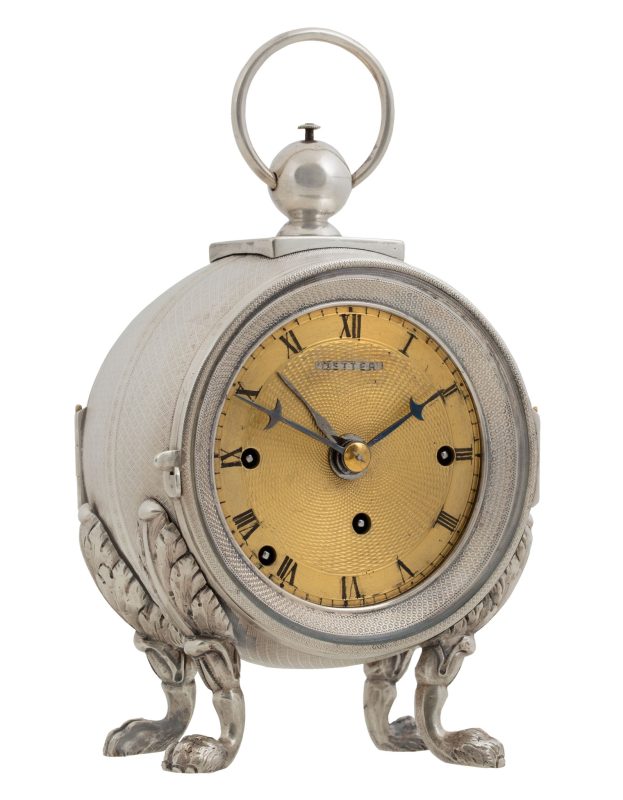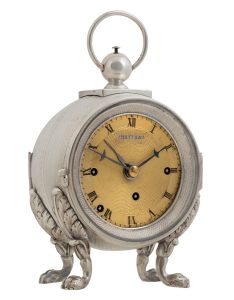Vienna, first half of the 19th century
- signed
- "Detter"
- Clockmaker
- Sebastian Dätter/Detter/Dötter II,
- Vienna, master 1826-57, mentd. 1836
- Case
- engine turned silver, four lion feet, glazed reverse side, Vienna hallmark for 13 lot silver (date 1834), master’s mark “J.W.” – Johann Georg Wächter, Vienna, silver smith, specialized on clock cases, active 1824-58
- Dial
- engine turned ormolu
- Movement
- verge escapement, ruby bearing, fine adjustment, Viennese grande sonnerie on wire gongs, repeater, turn-off for strike, alarm on wire gong
- Height
- 6 in
This particularly fine Viennese travel clock from the first half of the 19th century impresses with a detailed engine-turned silver case and complex movement technology despite its delicate dimensions with a height of only 6 in.
Four lion’s feet support the case drum, which is stamped with the Viennese hallmark for 13-lot silver. The date of the mark, which has become difficult to read over the course of almost 200 years, is probably 1834. The master’s mark „J. W.“ is located directly next to the silver mark. This belonged to the Viennese silversmith Johann Georg Wächter, who worked in the Danube metropolis between 1824 and 1858. Wächter was obviously a specialist in clock cases, as we have already discovered his hallmark on many other small silver clocks (mainly tiny tickers).
The case drum is adorned with a circumferential band of finely engraved graphic patterns known as guilloches. The bezel (the ring surrounding the dial) and the back of the case are also elaborately engine turned. Guilloches demanded the utmost precision and skill and were therefore produced by master guillocheurs. They used guilloché machines, special lathes that required many years of expertise to operate.
The ormolu dial is also engine turned and bears the clockmaker’s signature of Sebastian Detter II (also spelled Dätter or Dötter). Detter is named as a Viennese master from 1826 to 1857 and had his establishment on Mariahilfer Straße (then Mariahilfer Hauptstraße). He also owned a „Gewölbe“ (a sales store) in the city center. This was located in the so-called Hirschenhaus, a building that stood in the middle of the Graben in front of today’s Meinl-am-Graben. After this house was demolished in 1840 to enlarge the boulevard, Detter moved his downtown store to Kärntnerstrasse (on the corner of Krugerstrasse).
The movement with verge escapement, ruby bearing and fine adjustment has a Viennese grande sonnerie on wire gongs with repeater and turn-off for the strike. The fourth winding arbor is used for the alarm on wire gong, which can be set using the third hand on the lowest level of the motion work.

